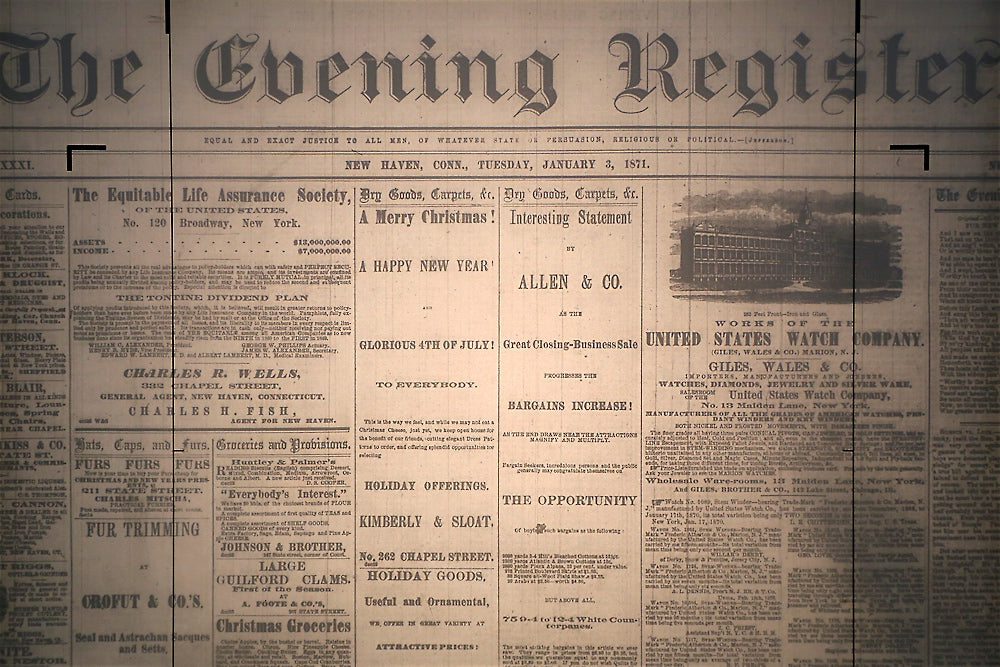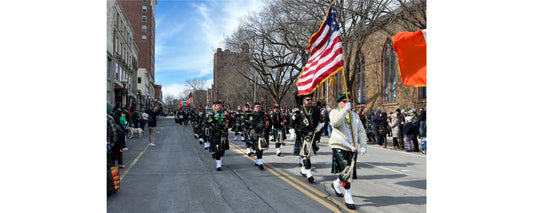It’s the last remaining “legacy” newspaper in the Elm City, the only one still published by pressing news ink to paper, then manually delivered to subscribers. It’s the New Haven Register, and, in one form or another, it’s been registering New Haven for over 200 years.
Most people likely don’t know this part of its history—I was a Register reporter and editor for almost eight years, and even I didn’t know it—but in its early days, the paper brought a contrarian—radical, even—voice to New Haven. The founder was New Haven native Joseph Barber, who printed the first edition, calling it the Columbian Register, from a hand-operated press in a Chapel Street print shop. According to Register archives, that first issue, published in 1812, was a four-pager, which made a lot of sense back then: you could print everything on the front and back of one sheet, then fold it in half, no collating required.
Barber, age 24, made no attempt at impartiality when he began publishing the Register. Readers of those early editions knew exactly what they were getting: partisan support of Thomas Jefferson’s Democratic-Republican Party, which stood opposed to the Federalists. Jefferson’s presidency from 1801 to 1809 had brought the cause to power nationally, but the Federalists had a strong foothold in Connecticut early in the 19th century, spurring Barber on.
sponsored by
There were two other papers in the city at the time—the Journal and the Connecticut Herald—and Barber immediately fired a shot across their bows. In an editorial printed in the Register’s first edition, he wrote that he started the Columbian Register to combat their “declamations against and misrepresentations of a government under which they enjoy inestimable privileges.”
Aside from Barber’s political views, early editions of the paper contained a column of helpful tips for farmers, reprints of Congressional correspondence, some wedding announcements and obituaries and, of course, a few advertisements. An ad in the very first edition, placed by Elihu Sanford of Woodbridge, offered a one-cent reward for the return of an indentured servant who’d run away.
By the time he retired in 1837, Barber had grown the Register substantially. When he died at age 94 in 1882, his obituary in what was by then renamed the New Haven Evening Register said he was “probably the oldest among the members of the printing and publishing guilds in this country.” It also noted, “The late Mr. Barber was not what is usually understood by the term ‘a popular man.’ He was very direct in the expression of his opinions and always did his own thinking.”
When Barber retired, the reins of the Register were handed over to Minott A. Osborn. It stayed in the Osborn family until 1895, when another local family, the Jacksons, took the helm. Soon after, John Day Jackson, a 27-year-old Yale University graduate, became the general manager. The paper, disseminated in the evening, had a daily circulation of 4,000 at the time, and if that sounds low, it’s because it wasn’t the only daily paper in town. Later, in 1926, Jackson responded to that situation by buying the rival New Haven Journal-Courier, distributed in the mornings.
In 1981, the Jackson family moved the Register and Journal-Courier from 367 Orange Street, downtown, to 40 Sargent Drive in Long Wharf. Then, in May 1986, it was announced that the family had sold the operation, which had an overall circulation of about 130,000, to newspaper conglomerate Ingersoll Publications for a whopping $170 million.
The next year, the two New Haven papers were merged together into a single morning daily, and three years after that, in 1990, an Ingersoll protégé named Bob Jelenic took the helm of the parent company, which was repackaged into the Journal Register Co. (Its flagship paper was none other than the New Haven Register.) He took JRC public in 1997 in order to facilitate an aggressive acquisitions strategy, buying up other papers around the country, and taking on mountains of debt to do it.
All the while, like many local dailies, the Register struggled to make sense of an increasingly internet-driven media landscape. The news became harder to scoop, and advertising dollars moved online. At the same time, the paper, like all other JRC papers, was paying a price for the parent company’s troubled financial situation.
Eventually, in 2009, JRC filed for bankruptcy protection, after which it became private once more. In 2011, Digital First Media was formed to control both JRC and another conglomerate, Media News Group; JRC then filed for bankruptcy again in 2012, and would soon be absorbed into surrounding corporate infrastructure.
Along the way, the Register’s staff has been drastically downsized via layoffs and, most recently, buyouts. The paper’s various satellite bureaus—Milford, Shoreline, Wallingford and others—that once populated the greater New Haven area have been shuttered. In another historic change, as of 2012, the paper was no longer printed in-house.
Today, the New Haven Register is run by another entity within Digital First called 21st Century Media, and change is still in the air. In August 2014, the paper left Sargent Drive for a smaller office at 100 Gando Drive, and a month later, Digital First officials announced that they’re open to selling the chain’s newspapers, including the Register. Available news reports indicate that that remains the case.
In spite of how it all looks from the outside, newsroom employees have told me they’re energized by the new digs, and a house editorial (“The Register’s wild ride continues in new space”), published on September 18, 2014, shows admirable pluck and good humor: “While the last move was an expansion during print’s heyday, this one is more like a Baby Boomer couple downsizing into a condo.”
Somehow, as other New Haven papers have come and gone, and as tempests have raged all around it, the Register has always endured, and even now, you get the sense that it means to press on.
New Haven Register
100 Gando Dr, New Haven (map)
(203) 789-5200
www.nhregister.com
Written by Cara Rosner. Photographed by Dan Mims. Image depicts the January 3, 1871, edition of The Evening Register, viewable on microfilm at the Ives Main Library. This lightly updated story was originally published on October 10, 2014.








